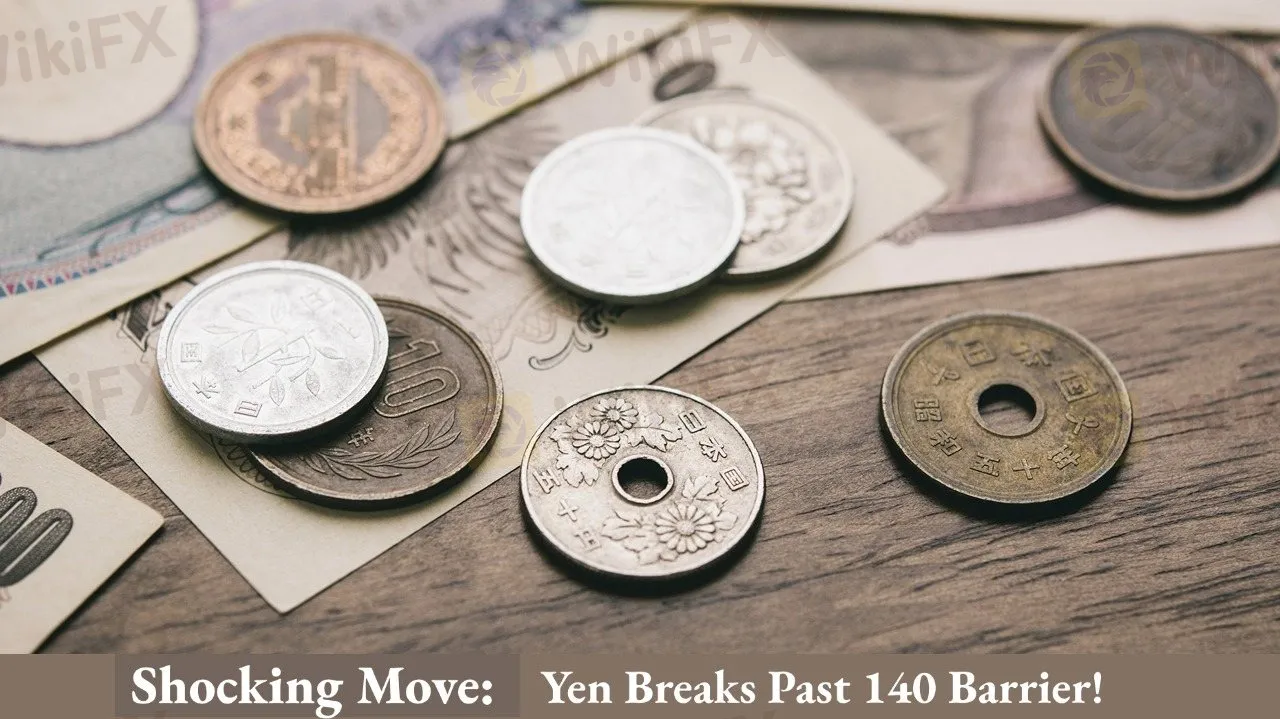简体中文
繁體中文
English
Pусский
日本語
ภาษาไทย
Tiếng Việt
Bahasa Indonesia
Español
हिन्दी
Filippiiniläinen
Français
Deutsch
Português
Türkçe
한국어
العربية
Shocking Move: Yen Breaks Past 140 Barrier!
Abstract:The yen's breakout above the 140 mark has caught global attention, and the reasons behind it are more than technical.

The Japanese yen surged past the critical 140 psychological level against the U.S. dollar this week, reaching 139.90—its highest point since September last year. This move is seen as a pivotal moment, signaling not just renewed interest in safe-haven assets, but also a shift in sentiment toward the dollars outlook.
Previously, the yen had stalled repeatedly around the 140 mark. However, this recent breakout is being viewed by analysts as a technical and psychological turning point. A solid move below 140 could trigger automatic buy orders, accelerating the yens strength and deepening dollar weakness. On Tuesday during Asian trading hours, the yen outperformed all other major G10 currencies, highlighting its renewed appeal as a haven during uncertain times.
This rally is far from accidental. Multiple fundamental forces have come together to support the yens strength. Chief among them is growing uncertainty around U.S. Federal Reserve policy. While the Fed is widely expected to begin cutting rates this year, the Bank of Japan appears committed to maintaining a gradual tightening path. This widening policy divergence favors yen appreciation as investors seek more predictable returns.
Additionally, speculative trading has amplified the move. According to the latest data from the Commodity Futures Trading Commission (CFTC), long positions on the yen have reached historical highs. This signals that traders are heavily betting on continued yen gains. From a technical standpoint, if the USD/JPY pair drops below the 139.60–139.50 support range, further downside may be in play.
Global economic uncertainty is also adding fuel to the fire. With growing concerns over trade tensions and slowing global growth, investors are turning to traditional safe-haven currencies like the yen. While the Bank of Japan has not yet intervened directly in the market, Japanese officials have voiced concern over the recent exchange rate movements. An upcoming meeting between Japans Finance Minister and his U.S. counterpart is expected to focus on these currency issues.
Despite recent gains, the road ahead for the yen remains complex. Global growth forecasts have been downgraded, and trade volumes are projected to contract slightly this year, reflecting ongoing macroeconomic headwinds. Export-dependent economies like Japan are particularly vulnerable to such downturns.
Moreover, talks between Japan and the U.S. on trade and currency matters remain delicate. Japanese officials have taken a firm stance, refusing to make concessions in key economic sectors, and this could prolong negotiations. Market uncertainty around these discussions is likely to continue influencing the yen's movements.
From a technical perspective, while the yen appears strong now, indicators such as the Relative Strength Index (RSI) suggest overbought conditions, implying a short-term pullback could be on the horizon. A brief dollar rebound or a pause in yen buying could trigger a corrective move.
Lastly, the market is closely watching for the Fed‘s next move. If upcoming U.S. economic data shows resilience, the pace of expected rate cuts could slow, giving the dollar some temporary support and potentially capping the yen’s upside in the near term.
Conclusion
The yen‘s breakout past 140 is more than a chart event—it reflects deep market concerns over policy divergence and global uncertainty. With geopolitical tensions, shifting central bank strategies, and cautious investor sentiment all in play, the yen may continue to attract safe-haven flows. For investors, staying tuned to both macro fundamentals and official statements will be key to navigating the yen’s next chapter.

Disclaimer:
The views in this article only represent the author's personal views, and do not constitute investment advice on this platform. This platform does not guarantee the accuracy, completeness and timeliness of the information in the article, and will not be liable for any loss caused by the use of or reliance on the information in the article.
Read more

Never Heard of Dynasty Trade? Here's Why You Should Be Worried
Have you heard this name before? No , it’s time you do because staying unaware could cost you. This platform is currently active in the forex trading and has been linked to several suspicious activities. Even if you’ve never dealt with it directly, there’s a chance it could reach out to you through ads, calls, messages, or social media. That’s why it’s important to know the red flags in advance.

WEEKLY SCAM BROKERS LIST IS OUT! Check it now
If you missed this week's fraud brokers list and are finding it difficult to track them one by one — don’t worry! We’ve brought together all the scam brokers you need to avoid, all in one place. Check this list now to stay alert and protect yourself from fraudulent brokers.

Catch the Latest Update on BotBro & Lavish Chaudhary
BotBro, an AI-based trading platform, became popular in India in 2024—but for negative reasons. Its founder, Lavish Chaudhary, who gained a huge following by promoting it heavily on social media. Since then, he has become well-known, but for many controversies. Let’s know the latest update about Botbro & Lavish Chaudhary.

Trading Other People’s Money | What Prop Firms Don’t Tell You
Proprietary (prop) trading firms have become increasingly popular. They give traders the chance to trade with larger amounts of money without risking their own savings. For many, this sounds like the perfect opportunity to grow faster and earn more. But while the benefits are appealing, there are also risks and hidden rules that traders must understand before joining a prop firm.
WikiFX Broker
Latest News
Asia-Pacific stocks fall as investors weigh recent trade developments
Is Your Forex Strategy Failing? Here’s When to Change
FSMA Warns That Some Firms Operate as Pyramid Schemes
Apex Trader Funding is an Unregulated Firm | You Must Know the Risks
LVMH shares jump 2.5% after reporting better-than-feared earnings, Texas factory plans
Why Octa Is the Ideal Broker for MetaTrader 4 & 5 Users
Stop Level Forex: How Does it Help Traders Prevail When Losses Mount?
5 things to know before the Thursday open: Meme stock revival, Trump's Fed visit, Uber's gender feature
CNBC's Inside India newsletter: Leaving, but not letting go — India's wealthy move abroad, but stay invested
Moncler raises prices on tariffs, may postpone store openings if downturn worsens
Currency Calculator


